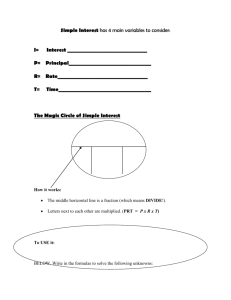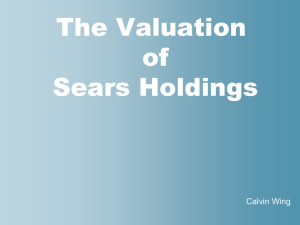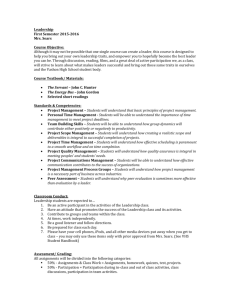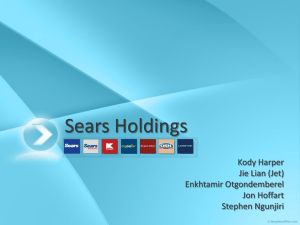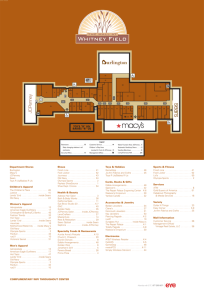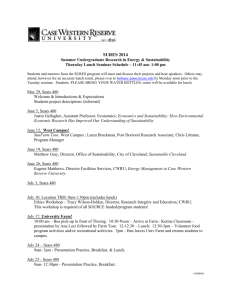Find a Zero - The Economist
advertisement
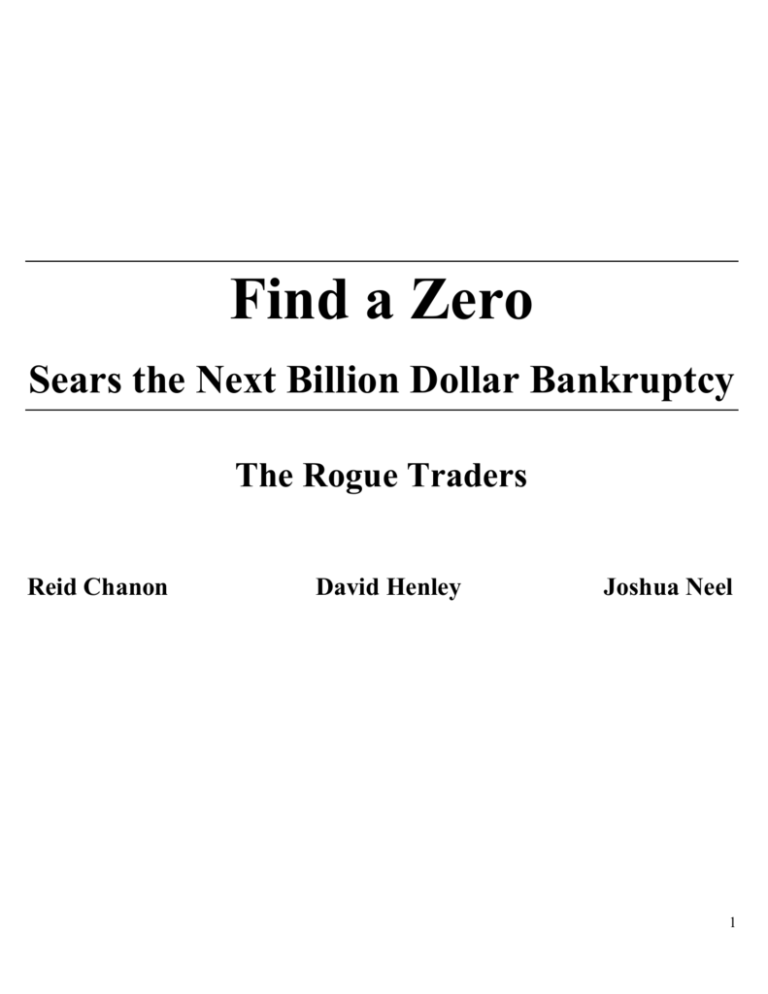
Find a Zero Sears the Next Billion Dollar Bankruptcy The Rogue Traders Reid Chanon David Henley Joshua Neel 1 Company Date 20 January 2015 Sector Consumer Discretionary Recommendation SELL Industry Department Stores Current Price 52-Week Range 36.57 22.45 – 48.25 Abstract Summary In this report, we will make the case that the publicly-traded US equity, Sears Holdings Corporation (SHLD), will likely file for Chapter 11 bankruptcy within the next five years. We will discuss various metrics that we believe are strong indicators of financial insolvency and place those measurements in the context of the broader department store industry. Next we will analyze current market trends and the impact they will have on Sears’ market value. Finally, we will find the true value of Sears and submit our recommendation to short the stock before the company’s eventual bankruptcy. Executive Summary We issue a SELL recommendation on Sears with the expectation that it will file for bankruptcy by 2020. Sears will be unable to capitalize on their strategic plans due to their inability to generate the necessary free cash flow to compete with industry members who have already established the necessary infrastructure and customer loyalty. These issues will be compounded by an unsustainable capital structure which will lead to Sears filing for Chapter 11 Protection For over a decade, Sears Holding Company has been declining despite having a large market share and numerous stores. This 121-year-old retail giant, though once thought invincible, is now primed for bankruptcy. Despite an infusion of $400 billion from its billionaire CEO, Eddie Lampert, and talks of spinning off stores into REITs, our findings indicate that this company has become obsolete in a radically changing industry. We will provide evidence of multiple downward trends found in Sears’ financial statements show that its movement toward bankruptcy may be accelerated over the next five years. Investment Overview Source: 10-K’s Despite trading at a fully diluted market capitalization of approximately $4 billion, Sears’ fundamentals have deteriorated steadily for the past five years or more. Its earnings per share have declined from $0.39 in 2009 to -$11.97 in 2014. Operating income (EBIT) has dropped similarly from $302 million to $927 million over the same 5 years. This loss in earnings creates a high cash 2 burn rate, indicating the company’s capacity to continue funding its cash flow needs with current cash-on-hand is limited. Such a cash shortage could force the firm to increase its total debt-to-total assets ratio by taking on additional debt, which has already tripled to 32.6 from 11.5 over the past 5 years. These factors cast doubt on the company’s solvency, and result in a reduced Altman Z-score to 1.3 down from 2.3. Source: Bloomberg Negative Earnings Source: Bloomberg One of the most important indicators of a firm’s growth potential is earnings per share (EPS). Sears’s EPS have declined a total of -$11.6 over the past 5 years, worse than the industry decline of -$3.8. To better understand where Sears has been losing money, we looked at operating margins, which are found by dividing operating income by total revenue. Operating margins reveal how well a company is pricing its products, how cheaply it is purchasing input materials, and how efficiently it is carrying out its core functions. We derived operating margins by dividing operating income into total revenue and discovered that Sears’ operating margins have decreased from .65 to -2.56 over the past 5 years. Because operating expenses have endured a similar decline over the same period, it appears that Sears has become less efficient with its day-to-day operations and is losing money as a consequence. Negative Cash Flow Source: Bloomberg Source: Bloomberg Source: Bloomberg With 2,249 retail locations across the United States and Canada, Sears controls roughly 2% of all available retail space. Due to its immense commercial footprint, Sears’ operating leases comprise a substantial amount of Sears’ future financial obligations, though they are currently listed off the balance sheet. This figure should be capitalized to the balance sheet in order to help investors gain an accurate representation of the firm’s condition. For example, as of 2014, Sears classified $3,646 million of its leases as “operating”, leaving them out of long-term liability calculations. In contrast, it has listed only $346 million of capital lease obligations on the balance sheet. Since operating leases represent future contractual obligations, we discounted back the value of estimated future payments using Sears’ appropriate cost of capital (ke). We calculate the weighted average interest rate on Sears’ outstanding debt to arrive at this figure, 2.7%, and the weighted average interest rate currently being used to calculate its capitalized lease obligations, 6.4%. Cash Burn The cash burn rate (CBR) shows the number of months a company can continue to operate using only its current levels of cash and cash equivalents and without 3 securing additional financing. As seen in the graph below, Sears’ CBR has declined over the past 10 years, implying. Even though free cash flows for the department store industry have declined by an average of 8% per year over the last decade, Sears’ has underperformed with an average annual decrease of -23%. Source: Bloomberg In the next graph, we examined the relationship between Sears’ cash flow from operations and its average current liabilities. This second metric reinforces the first graph by showing the inability of Sears to meet its current liability obligations given its current free cash flow from operations. As with first graph, this metric indicates Sears’ ability to meet its short-term obligations has deteriorated dramatically over the 10-year period. Free Cash Flow Because Sears carries large operating leases that are held outside the balance sheet, it is important to capitalized them, meaning discounting back the sum of future lease obligations and placing the present value on the balance sheet. This makes the firm’s true financial obligations more transparent and helps investors see a more accurate portrayal of the financial condition of the company. These leases total $2,929, augmenting both the debt-to-assets and debt service ratios. With declining cash flows, investors should investigate Sears’ ability to continue paying its interest requirements over the near future. In its current situation, with the latest CBR equal showing resilience of -8 months, its clear that Sears is already pulling money from other sources just to fund its everyday operations. High Leverage and Declining Credit Rating High leverage signals an underlying weakness in the firm’s projected ability to pay back outstanding debt. In Sears’ case, the debt-to-asset ratio has been increasing for the past 3 years, a result of declining cash flows and the need for new sources of cash to keep the firm afloat. When comparing Sears to its competitors, it is apparent that Sears is on the brink of being forced to liquidate assets in order to continue operations. Sears’ has suggested it will turn much of its unprofitable store space into a REIT as a means to generate cash by renting its buildings to other specialty retailers. 27% and 23% of Sears stores are in “weak local trade area demographics,” however, so pursuing this avenue will only expedite the eventual bankruptcy of the company. Much of this information, including the declining earnings and cash flows discussed above, have negatively affected the company’s Altman Zscore. This score measures Sears’ credit rating has declined dramatically, from 2.32 to 1.33. Since a score below 1.8 means there is a high probability a company will go bankrupt, Sears’ score of 1.33 is simply one indicator this company is headed for insolvency. 4 Porter’s Five Forces Model We used Porter’s Five Forces analysis to analyze the level of competition within the department stores industry (GICS). This framework allowed us to analyze competition within the industry and revealed what these firms must do to generate a profit. To analyze the retail industry we used J.C. Penney (JCP), Kohl’s. These companies are Sear’s closest competitors in terms of revenue, products, and target-market. The five firms (the representative firms) we chose are assumed to be indicative of industry trends for our analysis. Source: 10-K’s Intensity of Competitive Rivalry Short Name Macy's Kohl's Sears Holding J.C. Penney Market Cap Revenue T=0 Revenue T=(5) Geo 5 Yr Growth 21.75 13.81 3.86 2.49 27.93 19.03 36.19 11.86 24.89 16.39 46.77 18.49 2.90% 3.80% -6.20% -10.50% Source: Bloomberg Five Year Growth of Revenue Ticker YoY Growth SHLD -22.6% JCP -35.9% KSS 16.1% M 12.2% Industry -7.6% Source: 10-K’s High competitive rivalry causes a firm to establish and maintain customer loyalty, achieve efficient distributions, and minimize its prices. The elements of interest are the industry growth rate and the concentration of competitors. The components we selected have a material impact on the profitability of the industry. The industry growth was captured using the five year growth of revenue for the representative firms. The industry had an 8.5% decline in revenue over five years. We have identified changes in consumer tastes and the growth of Ecommerce as the primary contributors of this decline. Both will be discussed further in relation to threat of substitutes. The concentration of competitors has resulted in a saturated market that requires firms to compete on price and customer loyalty to maintain market share. There are eight U.S. firms in the department stores industry; however, when we include industries that compete with Sears’ there are 270 firms, 79 of them have a market capitalization greater than $1 billion. Threat of New Entrants Source: 10-K’s The ability of new firms to enter the retail industry has diminished over the past 10 years. While large department store chains have steadily increased their number of locations, it has become increasingly difficult for new entrants to find leasing and supply deals with manufacturers and retail outlets. As seen in the graph below, the leading department stores have grown their number of stores by an average of 5% annually over the past seven years. Sears, on the other hand, has decreased its number of locations by an average of -8%, highlighting its inability to maintain an aggressive stance in an industry where established brands should be exhibiting strength (1). Because this industry does not specialize in high-end products and brand recognition but rather deals in average goods and has few barriers to entry, E-commerce has the potential to take significant market share. 5 Short Name Market Cap Revenue T=0 Revenue T=(5) Geo 5 Yr Growth Macy's Kohl's Sears Holding J.C. Penney 21.75 13.81 27.93 19.03 24.89 16.39 2.90% 3.86 36.19 46.77 -6.20% 2.49 11.86 18.49 -10.50% Short Name Market Cap Revenue T=0 Revenue T=-5 Geo 5 Yr Amazon 176 88.99 24.51 E-Bay 69.76 17.9 8.73 Vipshop 14.47 3.77 2.8 Asos 2.75 0.98 0.17 Department Stores E-Commerce Mean -2.50% Correlation Mean Variance 0.49% -33.00% Variance Std. 7.00% Std. Deviation Deviation Source: Bloomberg 3.80% Growth 38.00% 19.70% 7.70% 55.90% 30.30% 4.46% 21.13% Threat of Substitutes The department stores industry has a low risk of substitute goods since they are primarily a retailer of branded merchandise. Since department store retailers produce very little, their main threat of substitutes are competitors offering alternative purchase methods. We have identified ecommerce as the retail industry’s greatest threat. E-commerce has encroached on the market share of the retail industry by a substantial margin. In order to demonstrate the magnitude of the effect we looked at revenue, which is the most appropriate way of isolating the market share for the retail industry. By comparing the five year geometric growth rates we identified that the retail industry is trending downwards, while E-commerce is growing rapidly. Then we looked at the correlation between the two industries to see how closely the effects vary together. With a correlation of -33% there is a moderate inverse relationship between the two industries. This historical growth, along with the 34.8% growth forecasted for the E-commerce firms in 2015, indicates that the retail industry should be expected to diminish by approximately 11.5%. This will result in the retail industry losing 7% of the revenues. The continued loss of revenues is creating a strain on the retail industry to generate positive cash flows from operations. The firms within the industry are adopting E-commerce programs to compete, but as we found in their 10-K reports, their inability to provide free delivery because of differences in their supply chain is a weakness and since they are dealing in low-end products, there are many alternatives available. Bargaining Power of Consumers Source: Company Data We have identified that the consumer has high bargaining power within the retail industry. Since the consumer is more concerned with the product than the store, the lowest price will generally prevail. This effect is maximized since firms in the department store industry predominantly have stores within and around shopping malls. This results in low switching costs for the consumer, since there are little to no transportation costs or information barriers. Furthermore, with the prevalence of the internet consumers are more prone to checking prices from many retailers. Therefore, the best way for a firm to succeed within this industry is to minimize their costs. Bargaining Power of Suppliers The suppliers for the retail industry have low bargaining power. The average department store has 170 distinct suppliers; therefore, if a supplier provides an 6 uncompetitive price, the demand for their product will drop significantly. Department stores are offered a low price since they have many alternatives and they don’t depend on few suppliers to provide a product that’s critical to the retailer’s business. The suppliers for the retail industry have low bargaining power. The average department store has 170 distinct suppliers; therefore, if a supplier provides an uncompetitive price, the demand for their product will drop significantly. Department stores are offered a low price since they have many alternatives and they don’t depend on few suppliers to provide a product that’s critical to the retailer’s business. The suppliers for the retail industry have low bargaining power. The average department store has 170 distinct suppliers; therefore, if a supplier provides an uncompetitive price, the demand for their product will drop significantly. Department stores are offered a low price since they have many alternatives and they don’t depend on few suppliers to provide a product that’s critical to the retailer’s business. Financial Analysis Based upon our research we conclude that Sears’ is trending towards bankruptcy. Sears has shown five key shortcomings: negative earnings, negative CFO and a high cash burn rate, and high leverage with a low credit rating. These issues are making Sears’ continued business operations unfeasible. Compounding the issue of Sears’ deficiencies is that its industry is performing nearly as bad. Sears’ Shortcomings Sears is failing because it isn’t adapting to change in consumer tastes efficiently enough. Before we look at the macroeconomic conditions contributing to its decline, we must first look at problems unique to Sears. Negative earnings – with an earnings growth of -451% over five years, Sears has become incapable of maintaining its market share or its operating margins, which have fallen to -2.56 (a 3.21 decline over 5 years). Negative cash flow from operations – High cash burn rate (CBR) – Sears has had a negative CBR since 2011, meaning they have to borrow cash to avoid running out of capital. The CBR average annual growth of Sears has been -23% during a 10 year period. High leverage – Sears leverage ratio has been increasing as it borrows capital to keep afloat. Its leverage is entering the realm where it may have to liquidate assets to remain in business. Low credit rating – Sears has a CCC+ (Standard & Poors) Caa (Moody’s) credit rating, which results in its bonds being considered “not investment grade.” This is detrimental since Sears is being forced to borrow to maintain an 7 adequate cash balance, but it is unable to borrow from most institutional investors. Department Stores Industry Decline The department stores industry is struggling, in large part because the industry is unable to adapt to changes in consumer preferences quickly enough. Sears has underperformed the industry in every performance measure we used, often being one of the worst two. The department stores industry has declined and should continue to decline because: High rivalry among existing firms – the consumer discretionary sector consists of 270 firms, this forces existing businesses to compete on price, efficiency, and consumer loyalty. By competing on efficiency, a firm’s margin will be adversely affected, causing unprofitable firms to decline faster. High risk of substitutes – As stated, the key component to being successful in this sector is to provide goods at a lower cost than the competitors. The incentive to minimize costs rewards companies with low fixed costs, which would be an E-commerce firm, not a large square footage department store. Price takers when selling merchandise – The consumer can choose to forgo one store for another since there is almost no differentiation between them. Furthermore, since department stores often compete within the same building there can be no transportation costs or imperfect information when choosing a retailer. This harms the profit potential of all firms within the industry. Recommendation We believe that Sears will be forced to file for bankruptcy by 2020 because of its inability to generate an accrual or cash based profit, it not maintaining a reasonable capital structure, and its industry’s failure to maintain a competitive advantage over non-traditional department stores. 8 Appendix A: Earnings, Cash Flow, and Leverage Operating Margin 8 6 4 2 0 -2 Sears Operating Margin -4 -6 09 10 11 12 13 14 9 Operating Margin 15 10 5 0 -5 -10 SHLD M KSS JCP -15 -20 09 10 11 12 13 14 CFO-to-Total Liabilities 12 10 8 6 4 2 0 -2 -4 -6 -8 CFO/Total Liabilities 09 10 11 12 13 14 CFO-to-Avg Current Liab 0.6 CFO/Avg Current Liab 0.5 0.4 0.3 0.2 0.1 0 -0.1 -0.2 05 06 07 08 09 10 11 12 13 14 10 Cash Burn Rate 60.00 Cash Burn Rate 40.00 20.00 (20.00) (40.00) (60.00) 05 06 07 08 09 10 11 12 13 14 Earnings Per Share 10 5 0 -5 -10 -15 -20 -25 SHLD KSS JCP M -30 09 10 11 12 13 14 11 Operating Income 1500 SHLD Industry 1000 500 0 -500 -1000 -1500 -2000 09 10 11 12 13 14 12 Appendix A: Five Forces, Cap. Leases, and Revenue Five Year Growth of Revenue Ticker YoY Growth SHLD -22.6% JCP -35.9% KSS 16.1% M 12.2% Industry -7.6% Force Rivalry Among Existing Firms Threat of New Entrants Threat of Substitutes Bargaining Power of Buyers Bargaining Power of Suppliers Strength High Moderately High High High Low 13 Rivalry Among Existing Firms 5 4 3 Threat of New Entrants 2 Threat of Substitutes 1 0 Bargaining Power of Buyers Short Name Market Cap Bargaining Power of Suppliers Revenue T=0 -10.5% Revenue T=0 Revenue T=-5 Geo 5 Yr Growth 176.00 88.99 24.51 38.0% E-Bay 69.76 17.90 8.73 19.7% Vipshop 14.47 3.77 2.80 7.7% 2.75 0.98 0.17 55.9% Kohl's Sears Holding J.C. Penney Short Name Amazon 27.93 19.03 36.19 11.86 Geo 5 Yr Growth 24.89 16.39 46.77 18.49 Macy's 21.75 13.81 3.86 2.49 Revenue T=(5) Market Cap Asos Department Stores 2.9% 3.8% -6.2% E-Commerce Mean -2.5% Correlation Variance 0.49% -33.0% Std. Deviation 7.00% Mean 30.3% Variance 4.46% Std. Deviation 21.13% Regression Statistics Coefficient _-0.996x + 0.278 Multiple R 33.00% R Squared Standard Error T Statistic 10.90% Observations 24.40% 2.11 4 E-Commerce Analyst Forecast 2014 Sales F12M Sales Growth 14 Amazon 88.99 105.24 18% E-Bay 17.90 19.35 8% Vipshop 3.77 6.89 83% Asos 0.98 1.27 30% Avg. Growth 34.8% 2014 Revenue Department Stores 54% E-Commerce 46% 2015 Revenue Department Stores E-Commerce 39% 61% 15
